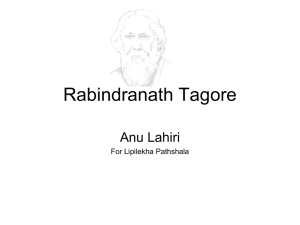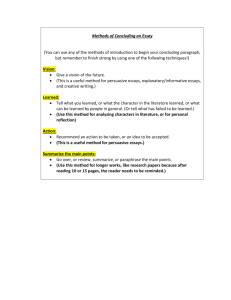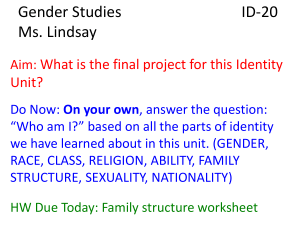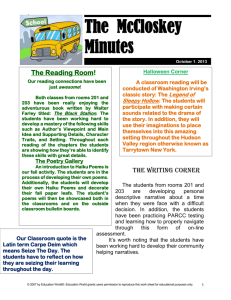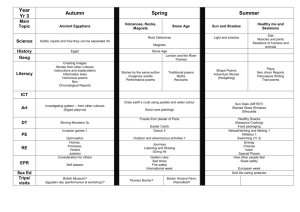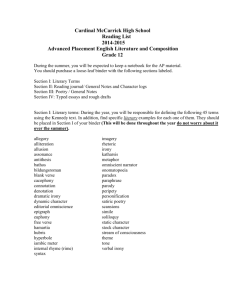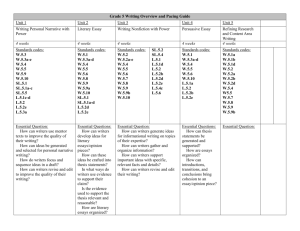AAESA Sample Curriculum - Grade 4 MAISA writing
advertisement
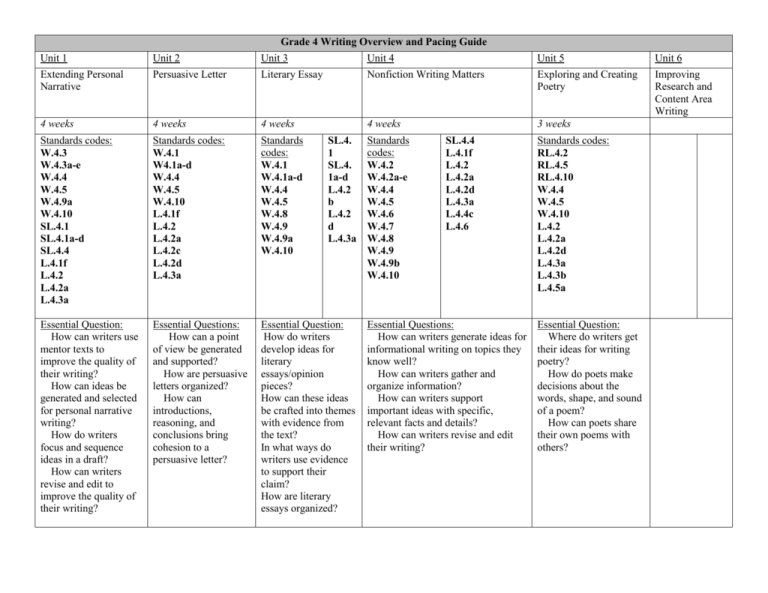
Grade 4 Writing Overview and Pacing Guide Unit 1 Unit 2 Unit 3 Unit 4 Unit 5 Unit 6 Extending Personal Narrative Persuasive Letter Literary Essay Nonfiction Writing Matters Exploring and Creating Poetry Improving Research and Content Area Writing 4 weeks 4 weeks 4 weeks 4 weeks 3 weeks Standards codes: W.4.3 W.4.3a-e W.4.4 W.4.5 W.4.9a W.4.10 SL.4.1 SL.4.1a-d SL.4.4 L.4.1f L.4.2 L.4.2a L.4.3a Standards codes: W.4.1 W4.1a-d W.4.4 W.4.5 W.4.10 L.4.1f L.4.2 L.4.2a L.4.2c L.4.2d L.4.3a Standards codes: W.4.1 W.4.1a-d W.4.4 W.4.5 W.4.8 W.4.9 W.4.9a W.4.10 Essential Question: How can writers use mentor texts to improve the quality of their writing? How can ideas be generated and selected for personal narrative writing? How do writers focus and sequence ideas in a draft? How can writers revise and edit to improve the quality of their writing? Essential Questions: How can a point of view be generated and supported? How are persuasive letters organized? How can introductions, reasoning, and conclusions bring cohesion to a persuasive letter? Essential Question: How do writers develop ideas for literary essays/opinion pieces? How can these ideas be crafted into themes with evidence from the text? In what ways do writers use evidence to support their claim? How are literary essays organized? SL.4. 1 SL.4. 1a-d L.4.2 b L.4.2 d L.4.3a Standards codes: W.4.2 W.4.2a-e W.4.4 W.4.5 W.4.6 W.4.7 W.4.8 W.4.9 W.4.9b W.4.10 SL.4.4 L.4.1f L.4.2 L.4.2a L.4.2d L.4.3a L.4.4c L.4.6 Essential Questions: How can writers generate ideas for informational writing on topics they know well? How can writers gather and organize information? How can writers support important ideas with specific, relevant facts and details? How can writers revise and edit their writing? Standards codes: RL.4.2 RL.4.5 RL.4.10 W.4.4 W.4.5 W.4.10 L.4.2 L.4.2a L.4.2d L.4.3a L.4.3b L.4.5a Essential Question: Where do writers get their ideas for writing poetry? How do poets make decisions about the words, shape, and sound of a poem? How can poets share their own poems with others? Important Skills: Generating narrative entries. Students learn how to generate ideas for personal narratives by first thinking of special people and places in their lives. Generating narrative entries. Students learn how to generate ideas for personal narratives by first thinking of strong emotion. Use concrete words and phrases. Students use concrete words and phrases to convey experiences and events precisely. Using sensory details. Students learn how to use senory details to help the reader experience the story. Building narratives using a story mountain. Students learn how to plan and organize their stories using a story mountain. Using transitional words. Students learn to use transitional words and phrases to manage the sequence of events. Including the internal story. Students slant their Important Skills: Analyzing persuasive texts. Students study mentor texts to analyze the audience, the issue, and the evidence. Generating ideas for persuasive writing. Students experiment with ideas for creating their own persuasive letters. Drafting a persuasive text. Students choose one idea and begin to draft a persuasive letter. Drafting a second persuasive text. Students draft a second persuasive letter and then choose one issue to develop into a finished piece of writing. Creating strong reasons. Students check the strength of their reasons and make necessary revisions. Creating an introduction. Students experiment with two ways to create an introduction for their persuasive letters. Building a supporting paragraph. Students Important Skills: Analyzing essays. St udents analyze literar y essays for the themes and supporting evidence. Using transitions. St udents use transitional words and phrases to link the evidence to the theme. Elaborating. Student s elaborate on the evidence by including specific details from the story. Creating a conclusion. Students write a conclusion that illustrates the significance of the theme. Determining a theme. Students dete rmine the theme in a new story and support it with evidence. Planning and organizing. Students plan and organize their ideas for a literary essay before they write. Building strong introductions. Stude nts learn how to build strong introductory paragrap hs for their literary essays. Slanting the evidence. Students le Important Skills: Important Skills: Creating poetry Analyzing informational using strong themes. texts. Students study Students write poems for informational texts and locate a class anthology in such ways in which the authors use a way that every word style and structure to make their matters. writing interesting. Considering Planning the categories for different perspectives. informational topics. Students Students write poems by generate topics, list subtopics, and choosing a perspective and organizing their think about everything they ideas. already know about these Using line breaks subtopics as they prepare to begin and verses. Students writing about a topic. shape poems by Writing about an experimenting with line informational topic. breaks and verses. Students choose a topic Expressing feelings. and record everything they know Students express their about their topic. feelings in poems by using vivid nouns and Using precise language. Students choose another topic and adjectives. Using humor and write all they know about each repetition. Students subtopic using precise include humor and language. They select one topic repetition in their poems. to develop into a final Generating ideas for writing project. student anthologies. Creating a Table of Students explore various Contents. Students create sources to determine interesting headings for each of topics for their own their subtopics and record them anthologies. Using model poems. on a Table of Contents. Students use published Drafting topic sentences and poems as models to details. Students begin by stating important information and write their own poems and create fitting then develop this information endings. using details as they draft their Using comparisons. first chapter. Students create images in the minds of readers stories by telling the internal story. Elaborating. Students learn how to elaborate by writing more than one sentence about each thing they want to say. Revising leads. Students learn how to improve their leads by studying the work of published authors. Revising conclusions. Students learn how to create strong conclusions by studying the work of published authors. Revision. Student revise for meaning and clarity. Editing. Students learn how to use a revision/editing checklist to edit their writing. Publishing personal narratives. Students write final drafts from their revised/edited personal narratives. Celebrate student work. learn how to use convincing language and transitional words and phrases to support their point of view. Building a second supporting paragraph. Students learn how to use information and examples to support their point of view. Building a third supporting paragraph. Students learn how to emphasize a point to support their point of view. Creating a concluding paragraph. Students learn how to summarize their point of view and make an appeal in their concluding paragraph. Revising. Students revise their persuasive letters using a checklist. Editing. Students edit their persuasive letters using a checklist. Publishing. Students write final drafts from their revised and edited persuasive letters. arn how to slant the evidence to support their theme. Providing specific details. Students pro vide specific details to support their evidence. Revising a literary essay. Students revis e their essays for meaning and clarity. Editing a literary essay. Students use a revision/editing checklist to edit their writing. Publishing a literary essay. Students creat e final drafts from their revised and edited literary essays. Sharing literary essays. Students share their published literary essays with an audience beyond the teacher. Including text features. Students make a plan for including text features to make their writing more clear and interesting. Using description. Students organize chapters using description and include key word and text features related to this structure. Using Chronology. Students organize chapters using chronology and include key word and text features related to this structure. Using comparison. Students organize chapters using comparison and include key words and text features related to this structure. Using cause and effect or problem/solution. Students organize chapters using cause and effect or problem/solution and include key words and text features related to this structure. Collecting information. Students collect information from a variety of sources for subtopics that need more information. Using narrative text structure. Students find places where they can provide information using narrative text structure. Using transition words. Students learn how to link ideas within categories of by using similes to make comparisons in their poems. Experimenting with shape. Students experiment with different ways to use shape in their poems. Using vivid verbs. Students use vivid verbs to help the reader picture the action in their poems. Creating a rhythm. Students experiment with accented and unaccented syllables to create a rhythm, or beat, in their poems. Using punctuation. Students use punctuation carefully in their poems. Revising poems. Students revise their poems for meaning, effective use of words and phrases, and structure. Editing poems. Students edit their poems for capitalization, punctuation, and spelling. Publishing poetry anthologies. Students create poetry anthologies from their revised and edited drafts. Sharing poetry anthologies. Students share their anthologies Assessment Tasks: Assessment Tasks: Conferring Checklist Revision/Editing Checklist Assessment Rubric Writing Continuum Conferring Checklist Revision/Editing Checklist Assessment Rubric Writing Continuum Assessment Tasks: Conferring Checklist Revision/Editing Checklist Assessment Rubric Writing Continuum information using transitional words to link ideas. Creating clear introductions. Students experiment with ways to introduce their topics clearly. Creating effective conclusions. Students write conclusions that relate back to the most important information about their topic. Creating glossaries. Students organize their important vocabulary words in alphabetical order and then locate and record the definitions. Revising and editing informational texts. Students revise and edit their informational texts. Publishing informational texts. Students create informational books from their revised and edited drafts Assessment Tasks: Revision/Editing Checklist Assessment Rubric Writing Continuum with an audience beyond the teacher. Assessment Tasks: Revision/Editing Checklist Assessment Rubric Writing Continuum

